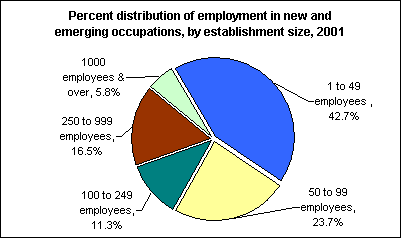New and emerging occupations at the start of the 21st century
January 05, 2005
In 2001, most new and emerging (N&E) occupations were in establishments with fewer than 100 employees, while the largest establishments accounted for the smallest percentage of N&E occupations.

[Chart data—TXT]
No single industry dominated in the creation and growth of new and emerging occupations; more than one-half were distributed among human services, transportation, communications, business and personal services, and a wide variety of wholesale and retail trade activities.
Some of the N&E occupations reported in 2001 included:
- Metal stud framer and epoxy floor installer. New building systems, particularly in commercial construction, and increased use of new materials explain the appearance of new occupations in the construction industry.
- Distance learning coordinator, home-school liaison, and technology infusion specialist. These workers deal with the use of new telecommunications applications and other technologies to deliver education.
- Bill review nurse. Nurses continue to be employed in areas other than those directly related to providing clinical care services. Many of the new jobs for nurses primarily involve controlling medical costs.
These data are from the Occupational Employment Statistics program. To learn more, see "New and emerging occupations," by Jerome Pikulinski in the December 2004 Monthly Labor Review.
OF INTEREST
Recent editions of Spotlight on Statistics
- Fatal Injuries to Foreign-Born Hispanic or Latino Workers
Explores the industries, occupations, and events related to these fatalities.
- For-Profit, Nonprofit, and Government Sector Jobs in 2022
Compares the labor force characteristics and experiences of workers in the for-profit, nonprofit, government, and self-employed sectors.
- Union Membership, Activity, and Compensation in 2022
Focuses on trends in union membership, work stoppages, and pay and benefits among union members.
- A Look at a Neat Industry: Distilleries
Examines trends in employment, establishments, wages, and consumer prices for distilleries.
- Healthcare Occupations: Characteristics of the Employed
Compares the demographic characteristics of workers in healthcare occupations.
 United States Department of Labor
United States Department of Labor

